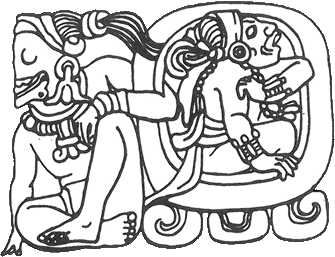| The Maya had very complex and interlocking calendar systems, which were as precise as modern day calendars. The Maya recorded time mainly using 3 interconnected calendars: the Tzolk'in (260 day count), the Haab (365 day count), and the Long Count. Most Maya dates were expressed as a combination
of the Tzolk'in and Haab. This combination is called a Calendar Round. |
Tzolk'in
|
| The Tzolk'in consists of the numbers 1 - 13 alternating against a cycle of 20 day names, with their number-day combination restarting every 260 days (13 x 20 = 260). For example (see figure 1), the iteration starts with the day 1 Imix and proceeds for 13 days to 13 B'en, then continues another 7 days counted from 1 Ix (day 14), 2 Men (day 15), 3 Kib'(day 16), etc, to 7 Ajaw — for a total of 20 days. Then the days will start over again with Imix, but continuing with the number sequence 8, or 8 Imix.
|
| Tzolk'in (20 day names) |
| Imix | Chuwen |
| Ik' | Eb' |
| Ak'bal | Ben |
| K'an | Ix |
| Chikchan | Men |
| Kimi' | Kib' |
| Manik' | Kab'an |
| Lamat | Etz'nab' |
| Muluk | Kawak |
| Ok | Ajaw |
| Figure 1 |
| 1 Imix | 11 Chuwen |
| 2 Ik' | 12 Eb' |
| 3 Ak'bal | 13 Ben |
| 4 K'an | 1 Ix |
| 5 Chikchan | 2 Men |
| 6 Kimi' | 3 Kib' |
| 7 Manik' | 4 Kab'an |
| 8 Lamat | 5 Etz'nab' |
| 9 Muluk | 6 Kawak |
| 10 Ok | 7 Ajaw |
|
Haab
|
| The Haab cycle repeats a series of 18 months of 20 days each (0-19), with an additional month of 5 days at the end (18 x 20 + 5 = 365). The months cycle is very similar to ours, for example (see figure 2) the month Pop begins and counts through 20 days, then goes on to the next month Wo.
|
| Haab (19 month names) |
| Pop | Yax |
| Wo | Sak |
| Sip | Kej |
| Sotz' | Mak |
| Sek | K'ank'in |
| Xul | Muwan |
| Yaxk'in | Pax |
| Mol | K'ayab' |
| Ch'en | K'umk'u |
| | Wayeb' |
| Figure 2 |
| 0 Pop (seating of Pop) | 11 Pop |
| 1 Pop | 12 Pop |
| 2 Pop | 13 Pop |
| 3 Pop | 14 Pop |
| 4 Pop | 15 Pop |
| 5 Pop | 16 Pop |
| 6 Pop | 17 Pop |
| 7 Pop | 18 Pop |
| 8 Pop | 19 Pop |
| 9 Pop | 0 Wo (seating of Wo) |
| 10 Pop | 1 Wo |
|
Long Count |
To keep track of linear time, the Maya created a positional notation system known as the Long Count. This is a number, used similarly to our numerical "year 2008," counting "years" and days since the last Creation in 3114 BC. (The "years" here counted, called Haabs, are only 360 days long.) Each 'digit' of the Long Count is twenty times the next one,
just as each digit of 2 0 0 8 is ten times the value of the following. We call our system, based on 10's, decimal notation; while the Maya system is vigesimal, based on 20's. The Long Count system counts in increments of twenty which provide the quantity of the b'aktun (400 years), k'atun (20 years), tun (360 days), winal (months), and k'in (days).
|
For example, the Gregorian date records:
| Monday, December 29th 2008 |
| Monday = One day in a named cycle of 7 days (week) |
| 29th = One in a numbered cycle of 28, 29, 30 or 31 days |
| December = One in a cycle of 12 named months |
| 363 = One in a cycle of 365 days |
| 2.0.0.8 AD/CE = A count of years since the birth of a Christian cycle |
|
To compare, this same date as written by the Maya records:
| 7 Manik' 10 K'ank'in 12.19.15.17.7 |
| Manik' = One day in a named cycle of 20 days (tzolk'in) |
| 7 = One in a numbered cycle of 13 days |
| K'ank'in = One in a cycle of 18 named months (haab) |
| 10 = One in a numbered cycle of 20 days |
| 12.19.15.17.7 = A count of years since the birth of a Maya Cycle |
|
|
|
|
| Click on the various links below to learn more about calendrics, how to convert a Gregorian date into a Maya date, and the glyphs associated with Maya dates. |
| Inga Calvin's Glyph Guide Section 1 - Calendrics |
| Date Conversions |
| Mark Van Stone's It's Not the End of the World: What the Ancient Maya Tell Us About 2012 |
| David Bolles explains The Mayan Calendar, The Solar - Agricultural Year, and Correlation Questions |
| Print Current Month Calendar |
|

